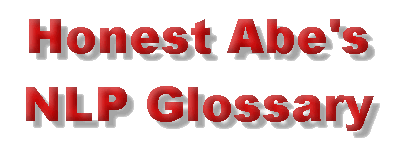

(author of "Develop Your NLP Skills", etc.)
PART 3
R - Z

|

|
|
|
(author of "Develop Your NLP Skills", etc.) |
||
|
PART 3 |
||
If there's anything you don't agree with, or which you think should be added, there is a "mail to" facility at the very end of this page. All constructive comments will be welcome.
Words in bold font are themselves explained somewhere else in the glossary.